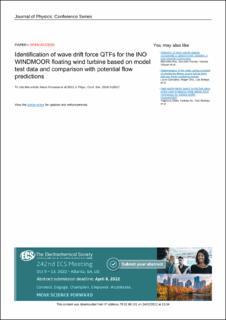| dc.contributor.author | Fonseca, Nuno | |
| dc.contributor.author | Thys, Maxime | |
| dc.contributor.author | Berthelsen, Petter Andreas | |
| dc.date.accessioned | 2022-03-23T14:34:02Z | |
| dc.date.available | 2022-03-23T14:34:02Z | |
| dc.date.created | 2021-11-19T09:53:00Z | |
| dc.date.issued | 2021 | |
| dc.identifier.citation | Journal of Physics: Conference Series (JPCS). 2021, 2018 . | en_US |
| dc.identifier.issn | 1742-6588 | |
| dc.identifier.uri | https://hdl.handle.net/11250/2987143 | |
| dc.description.abstract | The paper presents a comparison between empirical and numerical quadratic transfer functions (QTFs) of the horizontal wave drift loads on the INO WINDMOOR floating wind turbine. The empirical QTFs are determined from cross bi-spectral analysis of model test data obtained in an ocean basin. Validation of the identified QTF is provided by comparing low frequency motions reconstructed from the empirical QTF with measurements. The numerical QTFs are calculated by a panel code that solves the wave-structure potential flow problem up to the second order. Systematic comparisons between numerical and empirical QTFs allows identification of tendencies of empirical QTFs and limitations of the second order potential flow predictions. The study is limited to hydrodynamic loads from waves only, i.e. without current. For small seastates, the results indicate that the second order potential flow predictions of the surge QTFs agree quite well with the wave drift coefficients identified empirically from the model test data. For moderate and high seastates, second order predictions underestimate the surge wave drift coefficients for all compared diagonals of the QTFs. The discrepancies between predictions and empirical coefficients are not small, especially at the lower frequency range (below around 0.10 Hz) where the potential flow wave drift forces tend to zero. | en_US |
| dc.language.iso | eng | en_US |
| dc.publisher | IOP Science | en_US |
| dc.rights | Navngivelse 4.0 Internasjonal | * |
| dc.rights.uri | http://creativecommons.org/licenses/by/4.0/deed.no | * |
| dc.title | Identification of wave drift force QTFs for the INO WINDMOOR floating wind turbine based on model test data and comparison with potential flow predictions | en_US |
| dc.type | Peer reviewed | en_US |
| dc.type | Journal article | en_US |
| dc.description.version | publishedVersion | en_US |
| dc.rights.holder | Content from this work may be used under the terms of theCreative Commons Attribution 3.0 licence. Any further distribution of this work must maintain attribution to the author(s) and the title of the work, journal citation and DOI. Published under licence by IOP Publishing Ltd | en_US |
| dc.source.pagenumber | 11 | en_US |
| dc.source.volume | 2018 | en_US |
| dc.source.journal | Journal of Physics: Conference Series (JPCS) | en_US |
| dc.identifier.doi | 10.1088/1742-6596/2018/1/012017 | |
| dc.identifier.cristin | 1956261 | |
| dc.relation.project | Norges forskningsråd: 294573 | en_US |
| dc.source.articlenumber | 012017 | en_US |
| cristin.ispublished | true | |
| cristin.fulltext | original | |
| cristin.qualitycode | 1 | |

